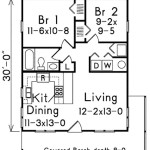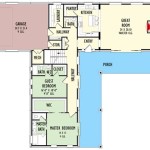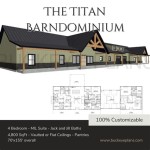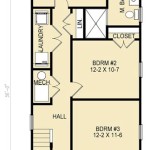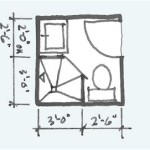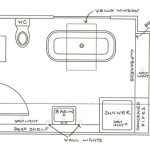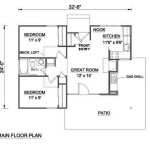Small One-Story Cottage House Plans: A Comprehensive Guide
The enduring appeal of the cottage house lies in its charm, compact size, and efficient use of space. Small one-story cottage house plans offer an attractive option for individuals and families seeking a manageable and aesthetically pleasing living environment. These plans are characterized by their emphasis on functionality, cozy ambiance, and often, a connection to the outdoors. This article will delve into the key aspects of small one-story cottage house plans, exploring their design considerations, common features, and potential benefits.
Cottage architecture historically evokes images of idyllic countryside dwellings, often featuring steeply pitched roofs, dormer windows, and quaint details. While modern interpretations may incorporate more contemporary elements, the core principles of simplicity, comfort, and natural integration remain central. These plans are particularly well-suited for those looking to downsize, build on a smaller lot, or create a vacation getaway.
Key Design Considerations for Small One-Story Cottages
Designing a small one-story cottage requires careful planning to maximize space and functionality. Several key considerations influence the overall design and livability of the home. These include space optimization, natural light integration, and the incorporation of outdoor living areas.
Space Optimization: Due to the limited square footage, efficient use of space is paramount. Open floor plans are frequently employed to create a sense of spaciousness and flow between living areas. Multifunctional furniture, such as sofa beds and storage ottomans, can help to maximize utility without sacrificing comfort. Built-in storage solutions, including shelving, cabinets, and window seats with integrated storage, are also crucial for minimizing clutter and maximizing usable space. Closets, pantries, and other storage areas should be strategically placed to minimize their footprint while providing ample storage capacity.
Loft spaces, accessible via ladders or compact staircases, can be incorporated to provide additional storage or a cozy sleeping area, although they technically breach the "one-story" designation. However, they can be designed to maintain the single-level living experience for the primary inhabitants. Careful consideration must be given to headroom and accessibility when incorporating lofts.
Natural Light Integration: Maximizing natural light is essential for creating a bright and inviting atmosphere in a small space. Large windows, strategically placed to capture sunlight throughout the day, can significantly enhance the perceived size of the interior. Skylights can be added to bring natural light into areas that may not have access to exterior walls. The placement of windows should also consider privacy and energy efficiency. Overhangs and awnings can help to reduce solar heat gain during the summer months, while allowing sunlight to warm the interior during the winter.
Light-colored interior finishes, such as paint and flooring, can reflect light and further enhance the brightness of the space. Mirrors can also be used strategically to create the illusion of more space and reflect light. In addition to windows and skylights, glass doors leading to outdoor living areas can also contribute to natural light integration.
Incorporation of Outdoor Living Areas: Extending the living space to the outdoors is a common feature in cottage house designs. Patios, decks, and porches can provide additional space for relaxation, dining, and entertaining. These areas should be designed to seamlessly integrate with the interior living spaces, creating a cohesive and inviting environment. A covered porch can offer protection from the elements, allowing for year-round enjoyment of the outdoors. Patios and decks can be landscaped with plants and flowers to create a natural and serene atmosphere.
Fire pits and outdoor kitchens can further enhance the functionality of outdoor living areas. The design of the outdoor spaces should complement the overall aesthetic of the cottage and reflect the surrounding landscape. Considerations should be given to privacy, shade, and wind protection when designing outdoor living areas.
Common Features of Small One-Story Cottage House Plans
Certain features are frequently found in small one-story cottage house plans, contributing to their characteristic charm and functionality. These commonly seen characteristics include a focus on simplicity, use of natural materials, and integrated architectural details that define the cottage style.
Emphasis on Simplicity: Cottage house plans typically prioritize simplicity in both design and construction. Straightforward floor plans, minimal ornamentation, and cost-effective building materials are often favored. This emphasis on simplicity not only reduces construction costs but also contributes to the overall cozy and unpretentious atmosphere of the cottage. The interior design often reflects this simplicity, with a focus on comfortable and practical furnishings. Minimalist décor and uncluttered spaces are common characteristics of cottage interiors.
The rooflines are often simple gable or hip roofs, which are relatively easy to construct and maintain. The exterior cladding may consist of traditional materials such as wood siding, shingles, or stone veneer. Interior finishes are often chosen for their durability and ease of maintenance, such as hardwood floors, tile, and painted walls.
Use of Natural Materials: Natural materials are frequently incorporated into cottage house designs to create a warm and inviting atmosphere and to connect the home to its natural surroundings. Wood is a common material used for exterior cladding, interior trim, and flooring. Stone can be used for fireplaces, foundations, and exterior accents. The use of natural materials contributes to the overall rustic and charming character of the cottage. The selection of natural materials should also consider sustainability and environmental impact.
Reclaimed wood and other eco-friendly materials can be used to reduce the environmental footprint of the construction. When selecting natural materials, it's important to consider their durability, maintenance requirements, and suitability for the local climate. For example, certain types of wood may be more resistant to insects and rot in humid climates.
Integrated Architectural Details: Cottage house plans often incorporate unique architectural details that contribute to their distinctive character. These details may include dormer windows, window boxes, shutters, and decorative trim. Dormer windows can add visual interest to the roofline and provide additional natural light and ventilation to the interior. Window boxes can add a touch of color and charm to the exterior. Shutters can provide privacy and protection from the elements. Decorative trim can be used to highlight architectural features and add visual interest.
Other common architectural details include covered porches, which provide a welcoming entrance and a space for outdoor relaxation. Fireplaces are often a focal point in the living room, creating a cozy and inviting atmosphere. Built-in bookshelves and cabinets can add functionality and character to the interior. These details should be carefully considered to ensure that they complement the overall design of the cottage and enhance its aesthetic appeal. The scale and proportion of these details should also be appropriate for the size of the cottage.
Potential Benefits of Small One-Story Cottage House Plans
Choosing a small one-story cottage house plan offers several potential benefits compared to larger or multi-story homes. These advantages include reduced construction and maintenance costs, increased accessibility and safety, and a greater sense of connection to the surrounding environment.
Reduced Construction and Maintenance Costs: The smaller footprint of a one-story cottage typically translates to lower construction costs. Less material is required for the foundation, framing, roofing, and exterior finishes. Labor costs may also be reduced due to the simpler construction process. Furthermore, smaller homes generally have lower maintenance costs. Heating and cooling expenses are typically lower due to the reduced volume of space to be conditioned. Property taxes may also be lower due to the smaller property value. The smaller yard also requires less maintenance, reducing the time and expense associated with lawn care and landscaping.
Repair and renovation costs are also typically lower due to the smaller size and simpler construction. For example, replacing the roof on a small cottage will likely be less expensive than replacing the roof on a larger multi-story home. Cleaning and general upkeep are also easier and less time-consuming in a smaller space.
Increased Accessibility and Safety: One-story homes offer increased accessibility for individuals with mobility issues. The absence of stairs eliminates the risk of falls and makes it easier for people with disabilities or limited mobility to navigate the home. This can be particularly beneficial for elderly individuals or families with young children. Additionally, one-story homes can be designed with wider doorways and hallways to accommodate wheelchairs and other mobility aids.
In terms of safety, one-story homes offer easier escape routes in the event of a fire or other emergency. All rooms have direct access to the exterior, making it easier to evacuate the building quickly. One-story homes are also less susceptible to damage from windstorms and earthquakes compared to multi-story buildings. This can provide peace of mind for homeowners, especially in areas prone to natural disasters.
Greater Connection to the Environment: Cottage house plans often emphasize a connection to the surrounding environment. Large windows and glass doors allow for ample natural light and views of the outdoors. Porches, patios, and decks provide outdoor living spaces that seamlessly integrate with the interior. The design of the cottage often incorporates elements that reflect the natural landscape, such as natural materials, earth tones, and landscaping that blends with the surrounding environment. This connection to nature can promote a sense of well-being and relaxation.
Cottage house plans are often designed to be energy-efficient, with features such as insulation, energy-efficient windows, and passive solar heating. This can reduce energy consumption and lower utility bills. Some cottage house plans may also incorporate sustainable features such as rainwater harvesting systems, solar panels, and composting toilets. The smaller size of the cottage also reduces its environmental footprint compared to larger homes. This can be appealing to homeowners who are concerned about sustainability and environmental conservation.

Outlook Free Personal Email And Calendar From Microsoft Cozy House Exterior Sims Plans One Story

27 Adorable Free Tiny House Floor Plans Craft Mart

1 Bedroom Single Story Cottage With Open Living Space Floor Plan Pool House Plans Tiny

One Story Cottage Style House Plan

Cottage House Plans Home Designs Floor With Photos

Plan 80624pm Simple One Story Home House Plans Cottage Country

One Story House Plans With Open Floor By Max Fulbright

Foster A Small One Story Cottage House Plan 9820

Best One Story House Plans And Ranch Style Designs

Stone Mountain Cabin Plans Tiny House Blog Sims

